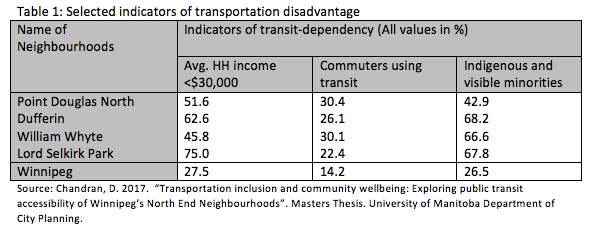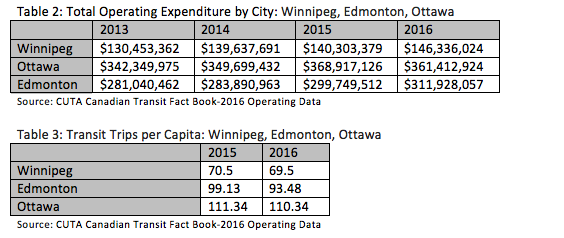By Ellen Smirl
Key Findings:
• Access to affordable, reliable, safe, and accessible transportation options is an important tool to help people lift themselves out of poverty and build a healthier city.
• Greater investment in transit and active transportation by all levels of government is needed
• Ensuring the benefits of investment are equally distributed needs to begin in the design stage
Transportation options in Winnipeg are not meeting the needs of the people who need them most. While significant discussion around transportation in Winnipeg is occurring, much of the current discussion focuses on how to attract new ridership and/or reduce congestion and greenhouse gases (GHG). Many people in Winnipeg however are struggling simply to get to work, school, grocery stores, medical appointments, and social activities.
While statistics for transportation disadvantage by neighbourhood cluster does not exist for Winnipeg, one recent study concluded that residents of the North End are more likely to be transportation disadvantaged than the rest of the city. The following table shows the connection between lower income neighbourhoods and reliance on public transit. Indigenous people and visible minorities are also more likely to rely on public transportation. Major indicators of transportation disadvantage include non-ownership of a vehicle, low-income, and minority ethnic identity.

Many transportation advocates are calling for increased equity when it comes to transportation planning. Transportation equity is the fair distribution of the benefits and costs, and in a way that meets the social and economic needs of the greatest number of residents, and especially those most vulnerable. Ensuring that everyone, regardless of physical ability or ability to pay has access to public transit and active transportation options is an important part of fighting poverty and inequality in Winnipeg.
To build a transportation system that works for most vulnerable we need to fully understand the challenges. The State of the Inner City Report 2018 (forthcoming) spoke with twenty people living in Winnipeg’s inner city and asked them about the barriers they experience in getting where they need to go. We also hosted a townhall discussion at the Thunderbird House on September 25th 2018 where all inner-city residents were invited to attend. This is what we heard.
Challenges
When it comes to taking transit, many people spoke about not being able to afford the fare. In January 2018 Winnipeg Transit raised fares by 25 cents in response to a $10M operational budget shortfall, which occurred when the Province froze their contribution to Winnipeg Transit at 2016 levels. Many people we spoke with said that they would sometimes go without food to afford a bus pass so they could get to work, while others said they would sometimes walk long distances so they could afford to buy groceries. This is a trade-off no one should have to make.
All of the people we spoke to said that schedules and time represented a major barrier in getting where they needed to go. Many spoke about buses not being on time. This is supported by statistics with weekday on-time reliability declining from a high of 80 per cent to 74.8 per cent in 2017. One young man spoke of the challenge in taking the bus to get to his workplace. His worksites would vary throughout the city, sometimes in areas with poor bus service. Despite getting up very early he would sometimes be late to work because late buses often resulted in missed connections. Transit needs to get people to where they want to go when they need to be there.
Many people we spoke with talked about fears about walking alone at night as well as waiting at bus stops, and some spoke about concerns about safety while riding the bus. Some young women spoke about being solicited for sex in exchange for fare by cab drivers. One young Indigenous women even spoke about how she was almost abducted walking by herself at night in the inner city.
I don’t feel safe at night. Once, I was walking around and this guy, he pulled up close to me, and he tried to grab me so I punched him and I just ran.
Incorporating equity into the transportation system means that we bring in a historical understanding of the history of Missing and Murdered Indigenous Women and Girls into the planning of the system and ask ourselves, “How can we design systems to better protect Indigenous women and girls?”.
Accessibility is another major barrier for community members. We spoke with six seniors with various mobility issues and one person that is wheelchair dependent. Again, affordability and scheduling were the two biggest barriers. Many seniors and people living with a disability have fixed-incomes, which makes getting where they need to go, at times, unaffordable. Many spoke about feeling isolated and lonely, especially during the winter months. Those with mobility issues and the elderly often struggle to carry groceries which means food security is also at risk.
For people using Handi-Transit, scheduling was a major issue. Staff at a senior’s home we spoke to said that many of their residents depend on Handi-Transit to get to medical appointment but because of the high demand for services, people are often required to get to their medical appointment hours early and wait long after they are done. For people with diabetes who need to stick to a scheduled eating time, or even for those with incontinence issues, this presents dangerous and humiliating challenges.
What people need
Most other major Canadian cities have a low-income bus pass and Winnipeg should not be the exception. Ensuring that people can get to their jobs and other opportunities is an important tool in fighting poverty. Additionally, ninety per cent of attacks against bus drivers involve fare disputes which demonstrates that a low-income bus pass will not only make fares more affordable, but also make a safer workplace for drivers.
Winnipeg is currently planning for the development of a coordinated and integrated transit plan that includes a Frequent Service Transit Network, Rapid Transit and electrification. This is to be applauded. Winnipeg can do even better by integrating the Transit plan with Winnipeg’s Pedestrian & Cycling Strategies to encourage inter-modal travel. Many low-income residents supplement their transit use with walking and bike riding and they frequently said they don’t feel safe riding bikes alongside cars, nor walking through certain areas especially at night. Greater discussion about how to improve safety-besides simply throwing more police at the problem-also needs to take place.
The report of the Task Force Reviewing Handi-Transit Issues adopted by Council on Sept 21 1994 stated that the characteristics of a transportation service for physically disabled persons should be reasonably equivalent to the service provided to able-bodied persons by the regular fixed route system. Disability advocates have been vocal that the quality of Handi-Transit services is not a reasonable equivalent. Many people we spoke with said that service has eroded since the City has contracted out this service to private companies and advocates say they would like to see Handi-Transit brought back in-house.
Big picture
Other cities are investing in transit and it’s paying off. While Winnipeg spends approximately $200 per person on transit, Edmonton spends closer to $300 and Ottawa spends over $400 per person. Ottawa residents take 40 more trips per year than Winnipeggers.

Encouragingly, in June 2018 the Federal and Provincial governments announced a bilateral cost-sharing agreement that will see a $530 million investment to public transit infrastructure for Manitoba municipalities. This is great news although questions remain as to whether this agreement will be affected by the Province’s recent decision to scrap the Carbon Tax. Regardless, investment dollars in infrastructure needs to be met with investment in the operational budget. Province needs to step up and restore the 50/50 funding agreement for Winnipeg Transit operating costs. A recent poll shows that four out of five Winnipeg voters are in favour of this.
From a revenue perspective, the recently scrapped Carbon Tax would have represented an incredible opportunity to raise revenue for investment in Winnipeg Transit operations as well as improving active transportation options like developing more bike lanes and pedestrian infrastructure to get people where they need to go. While the Province’s Made-in-Manitoba Climate and Green Plan states that one of its goals is to ‘support greater use of active or public transportation’, how remains unclear.
Finally, investment in transit and active transportation needs to be undertaken with a mind towards distributing the benefits in an equitable manner. Other cities are doing this. In 2004, Denver voters approved FasTracks, a $7.8 billion transit expansion. Mile High Connects (MHC) was formed shortly after to help ensure that considerations of equity went into the planning of newly built transit lines. MHC is a cross-sector collaborative of non-profits, foundations, businesses, and government leaders in the Denver region that makes an explicit connection between public transit and health equity. Their goal is to ensure that Denver’s new transit development benefits low-income communities and communities of colour by connecting them to the services they need the most such as jobs, healthcare providers, schools, grocery stores, parks and other essential destinations.
We currently have an incredible opportunity to develop more equitable transportation policy in Winnipeg. The Winnipeg Transit Master plan request-for-proposals just closed and the Our Winnipeg plan-which includes a section on sustainable transportation- is currently being updated. The City should ensure that these plans are developed with an eye to equity so that accessible and affordable transit options are created for everyone, especially the city’s most vulnerable. With increasing suburbanization of poverty in Winnipeg, the time to embed equity policies into transportation policy is now.
Ellen Smirl is a researcher with the Canadian Centre for Policy Alternatives – Manitoba. Transportation equity is the theme of this year’s State of the Inner City Report. The full report and findings will be launched in December 2018.


